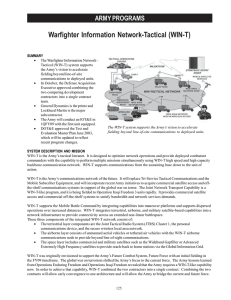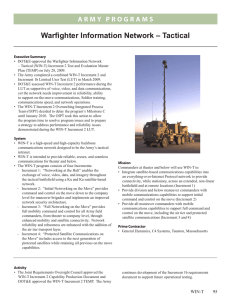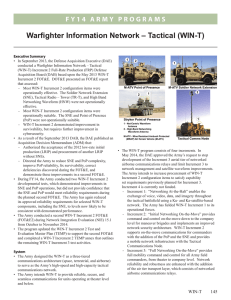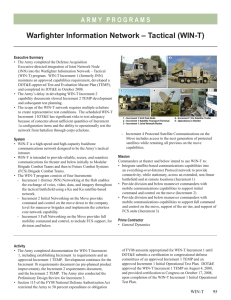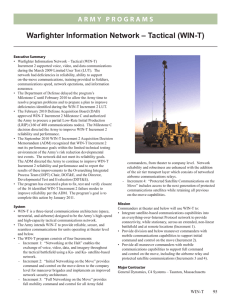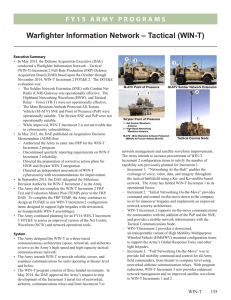WIN-T Increment 2: Army Tactical Network Evaluation
advertisement
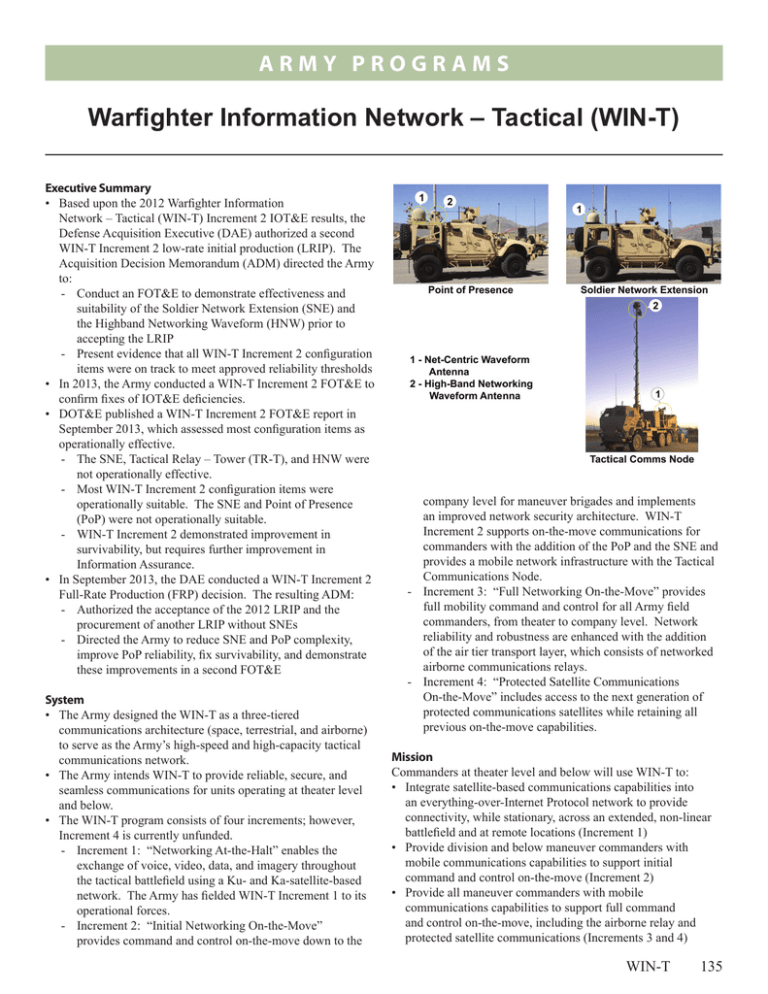
ARMY PROGRAMS Warfighter Information Network – Tactical (WIN-T) Executive Summary • Based upon the 2012 Warfighter Information Network – Tactical (WIN-T) Increment 2 IOT&E results, the Defense Acquisition Executive (DAE) authorized a second WIN-T Increment 2 low-rate initial production (LRIP). The Acquisition Decision Memorandum (ADM) directed the Army to: - Conduct an FOT&E to demonstrate effectiveness and suitability of the Soldier Network Extension (SNE) and the Highband Networking Waveform (HNW) prior to accepting the LRIP - Present evidence that all WIN-T Increment 2 configuration items were on track to meet approved reliability thresholds • In 2013, the Army conducted a WIN-T Increment 2 FOT&E to confirm fixes of IOT&E deficiencies. • DOT&E published a WIN-T Increment 2 FOT&E report in September 2013, which assessed most configuration items as operationally effective. - The SNE, Tactical Relay – Tower (TR-T), and HNW were not operationally effective. - Most WIN-T Increment 2 configuration items were operationally suitable. The SNE and Point of Presence (PoP) were not operationally suitable. - WIN-T Increment 2 demonstrated improvement in survivability, but requires further improvement in Information Assurance. • In September 2013, the DAE conducted a WIN-T Increment 2 Full-Rate Production (FRP) decision. The resulting ADM: - Authorized the acceptance of the 2012 LRIP and the procurement of another LRIP without SNEs - Directed the Army to reduce SNE and PoP complexity, improve PoP reliability, fix survivability, and demonstrate these improvements in a second FOT&E System • The Army designed the WIN-T as a three-tiered communications architecture (space, terrestrial, and airborne) to serve as the Army’s high-speed and high-capacity tactical communications network. • The Army intends WIN-T to provide reliable, secure, and seamless communications for units operating at theater level and below. • The WIN-T program consists of four increments; however, Increment 4 is currently unfunded. - Increment 1: “Networking At-the-Halt” enables the exchange of voice, video, data, and imagery throughout the tactical battlefield using a Ku- and Ka-satellite-based network. The Army has fielded WIN-T Increment 1 to its operational forces. - Increment 2: “Initial Networking On-the-Move” provides command and control on-the-move down to the company level for maneuver brigades and implements an improved network security architecture. WIN-T Increment 2 supports on-the-move communications for commanders with the addition of the PoP and the SNE and provides a mobile network infrastructure with the Tactical Communications Node. - Increment 3: “Full Networking On-the-Move” provides full mobility command and control for all Army field commanders, from theater to company level. Network reliability and robustness are enhanced with the addition of the air tier transport layer, which consists of networked airborne communications relays. - Increment 4: “Protected Satellite Communications On-the‑Move” includes access to the next generation of protected communications satellites while retaining all previous on-the-move capabilities. Mission Commanders at theater level and below will use WIN-T to: • Integrate satellite-based communications capabilities into an everything-over-Internet Protocol network to provide connectivity, while stationary, across an extended, non-linear battlefield and at remote locations (Increment 1) • Provide division and below maneuver commanders with mobile communications capabilities to support initial command and control on-the-move (Increment 2) • Provide all maneuver commanders with mobile communications capabilities to support full command and control on-the-move, including the airborne relay and protected satellite communications (Increments 3 and 4) WIN-T 135 Army PROGRAMS Major Contractor General Dynamics, C4 Systems – Taunton, Massachusetts Activity • In May 2012, the Army conducted a WIN-T Increment 2 IOT&E as part of Network Integration Evaluation (NIE) 12.2. DOT&E published a WIN-T Increment 2 IOT&E report to support a September 2012 FRP decision. The SNE, TR-T, and HNW waveform were not effective. All other configuration items and the Net Centric Waveform (NCW) were effective. WIN-T Increment 2 was not suitable due to poor reliability and maintainability, and not survivable due to Information Assurance deficiencies. • In September 2012, the DAE authorized a second LRIP. The ADM directed the Army to: - Conduct an FOT&E to demonstrate effectiveness and suitability of the SNE and the HNW waveform prior to accepting the LRIP. - Present evidence that all WIN-T Increment 2 configuration items were on track to meet approved reliability thresholds. • The Army conducted two Risk Reduction Events during 2QFY13 under benign conditions at the contractor’s facility at Taunton, Massachusetts. • In May 2013 as part of NIE 13.2, the Army conducted the WIN-T Increment 2 FOT&E in accordance with a DOT&E‑approved test plan. The test employed the 2nd Brigade, 1st Armored Division under operationally realistic conditions at Fort Bliss, Texas, and White Sands Missile Range, New Mexico. • In September 2013, DOT&E published a WIN-T Increment 2 FOT&E report in support of the September 2013 FRP decision. • In September 2013, the DAE conducted a WIN-T Increment 2 FRP decision. The ADM: - Authorized the acceptance of the 2012 LRIP and the procurement of another LRIP without SNEs - Directed the Army to reduce SNE and PoP complexity, improve PoP reliability, fix survivability, and demonstrate these improvements in a second FOT&E • The Army continues planning for a second FOT&E during the October through November 2014 NIE 15.1. Assessment • The Army’s Risk Reduction Events demonstrated improvements of the SNE, HNW switching, and Information Assurance. • Based on FOT&E performance, DOT&E assessed most of the WIN-T Increment 2 configuration items as operationally effective. The following components were not operationally effective in both FOT&E and IOT&E: - SNE. The SNE was useful for conducting Voice over Internet Phone (VoIP) calls but the utility of VoIP was limited by long call set-up times. The SNE’s mission command applications and Combat Net Radio Gateway did 136 WIN-T not support the company’s mission. The SNE’s startup and shutdown procedures were complex, lengthy, and required the vehicle to be at-the-halt. Fifteen of fifteen company commanders found the SNE distracting and indicated they would not take it to war. - HNW. The HNW cycling problem noted in IOT&E was improved and did not affect the unit’s mission. The Army corrected this problem by adjusting HNW parameters that reduced the HNW’s ability to carry the brigade’s network traffic. During FOT&E, 30 percent of the brigade’s network traffic went over line-of-sight HNW compared to 60 percent during IOT&E. The transmission range of HNW in terrain with blockage (e.g., dense vegetation) remains unchanged and poor. - TR-T. The single TR-T employed at brigade was not sufficient to extend range and allow HNW to cover the area-of-operations of the brigade during combat. • DOT&E assessed the Tactical Communications Node, Vehicle Wireless Package, TR-T, and Network Operations and Security Center as operationally suitable during FOT&E. • DOT&E assessed the following WIN-T Increment 2 configuration items as not operationally suitable during FOT&E: - PoP. The PoP is not reliable, too complex to operate, and did not meet its maintainability requirement. - SNE. The SNE is not reliable, too complex to operate, and did not meet its maintainability requirement. • DOT&E assessed WIN-T Increment 2 survivability as improved, but the system continues to have Information Assurance vulnerabilities. The details are provided in the classified annex to the FOT&E report. Recommendations • Status of Previous Recommendations. The program addressed all FY12 recommendations. The program still needs to improve SNE and HNW deficiencies noted during the WIN-T Increment 2 IOT&E. • FY13 Recommendations. The Army should: 1. Continue the reliability growth plan to improve the WIN-T Increment 2 reliability shortfalls highlighted during FOT&E. Reliability improvements should be demonstrated during a future operational test event. 2. Reduce SNE and PoP complexity of operations and troubleshooting. Demonstrate their suitability in a future operational test event. 3. Improve HNW and TR-T to gain better transmission range from the radio and increase the number of TR-Ts available to support units in dispersed operations.

